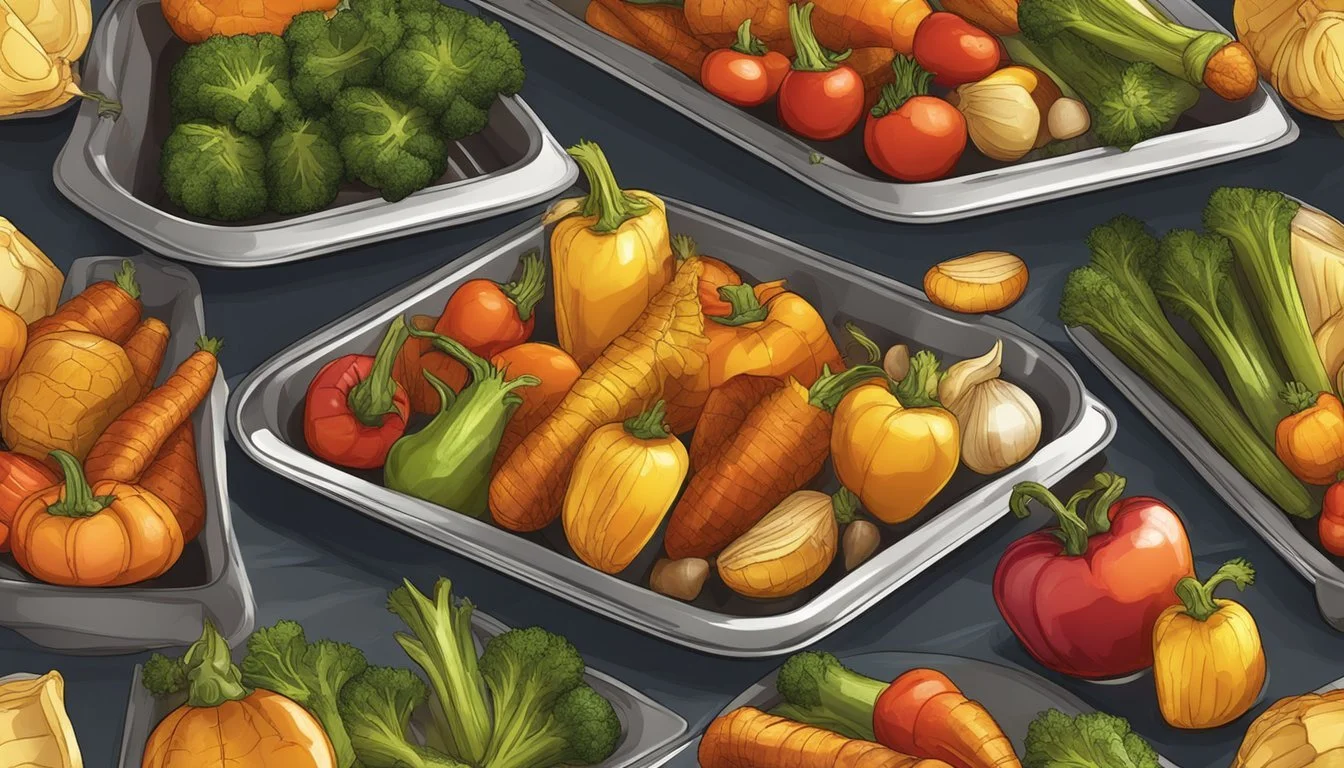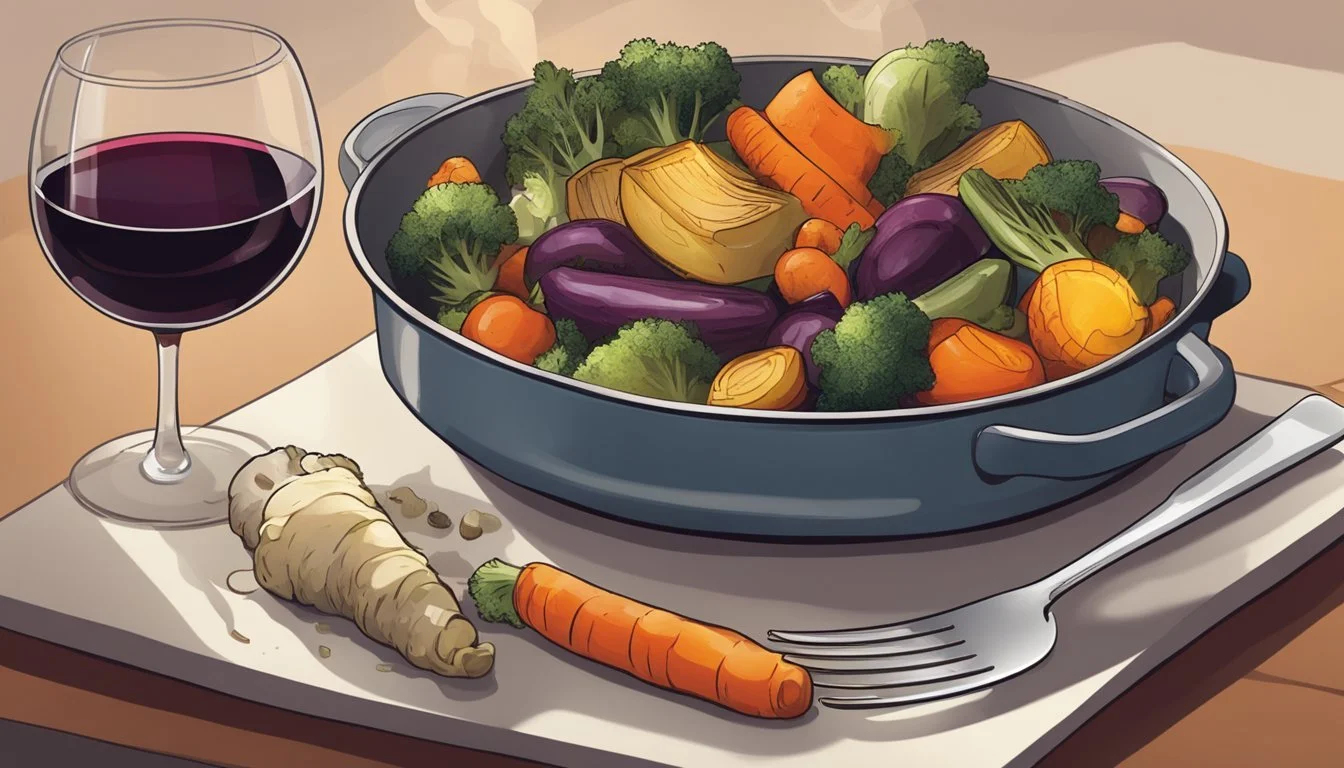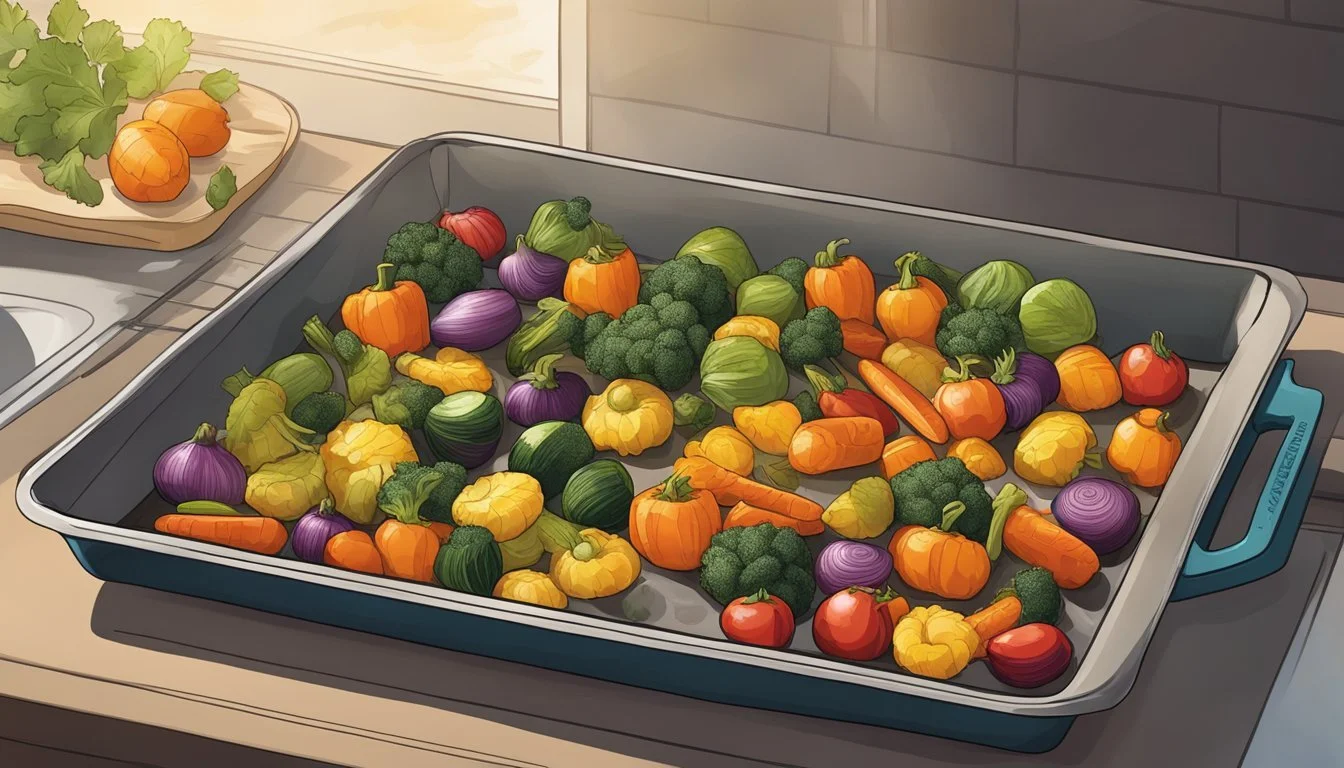Best Way to Reheat Roasted Vegetables
Tips for Flavorful, Tender Results
Roasted vegetables (What wine goes well with roasted vegetables?) are a go-to for a healthy, flavorful side dish that pairs well with a variety of meals. However, the challenge arises when it comes to reheating leftovers. Maintaining the savory taste and pleasing texture of roasted vegetables upon reheating is key to enjoying them just as much as when they were freshly made. The methods chosen for reheating play a pivotal role in preserving their original quality.
Many might resort to a microwave out of convenience, but this may lead to soggy or unevenly warmed vegetables. Meanwhile, using an oven or stovetop can enhance the flavors and bring back the satisfying crunch. It’s important to approach the reheating process with a technique that not only warms the vegetables but also rejuvenates their texture and taste. Therefore, a balance must be found between ease of reheating and the quality of the resulting dish, to ensure that the vegetables are just as enticing the second time around.
Understanding the Fundamentals of Reheating Roasted Vegetables
Properly reheating roasted vegetables is essential to maintaining their flavor and texture. The following information outlines key considerations for optimal reheating methods.
Importance of Preserving Flavor and Texture
When one reheat roasted vegetables, they aim to preserve the vegetables' original flavor and texture. The caramelization and crispness developed during the roasting process are desirable qualities that can be diminished if reheated incorrectly. Retaining the roasted vegetables’ moisture is also crucial to avoid sogginess and keep the flavors intact.
Different Methods of Reheating
Oven: Utilizing the oven for reheating is beneficial in preserving the vegetables’ moisture and preventing drying out. It is recommended to:
Preheat the oven to 350°F (175°C).
Spread the vegetables in a single layer on a baking sheet to ensure even reheating.
Reheat for about 5-10 minutes or until warmed to preference.
Microwave: While the microwave is convenient, it may unevenly reheat and affect the texture adversely. If one opts for this method, they should:
Place the vegetables on a microwave-safe dish.
Use the reheat setting or heat on high for 2-3 minutes, checking periodically.
Stovetop: For crispier results, the stovetop method involves:
Heating a bit of oil in a pan over medium heat.
Adding the vegetables in an even layer.
Cooking for 4-5 minutes, flipping halfway through.
Air Fryer: Reheating with an air fryer can recreate the texture of roasting:
Preheat the air fryer to 375°F (190°C).
Place the vegetables in the basket in one layer.
Heat for 3-4 minutes, checking for desired crispness.
Grill: Although less common, the grill can impart a smoky flavor and is optimal in dry weather to prevent sogginess. To reheat:
Preheat the grill to a medium setting.
Wrap vegetables in foil or place them in a grill basket.
Reheat for a few minutes, turning occasionally.
Each method has its merits and is best chosen based on the vegetables' composition and the desired outcome.
Preparing Roasted Vegetables for Reheating
Reheating roasted vegetables properly begins with correct storage to maintain their flavor and texture. This process ensures that the vegetables are not only tasty but also safe to consume.
Proper Storage Techniques
Storing roasted vegetables begins immediately after cooking. Allow them to cool to room temperature, but no longer than two hours to minimize the risk of bacterial growth. Once cooled, one should transfer the roasted vegetables into an airtight container, layering them between sheets of parchment paper to prevent sticking. If using aluminum foil, ensure it's tightly sealed around the vegetables to maintain freshness.
In the fridge: Roasted vegetables can be stored in the refrigerator for 3-4 days.
Freezing: For longer storage, vegetables can be flash frozen on a baking sheet lined with parchment paper and then transferred to a freezer-safe airtight container or bag, lasting up to 6 months.
Safety Considerations Before Reheating
Before reheating, check for any signs of spoilage such as mold or off-odors. Discard any leftovers that show these signs to avoid the risk of foodborne illness. When frozen, one should thaw the vegetables in the fridge, not at room temperature, to keep them out of the bacteria growth danger zone. Always ensure that the vegetables reach an internal temperature of 165 degrees Fahrenheit when reheating to eliminate any potential bacteria.
Reheating Roasted Vegetables in the Oven
Reheating roasted vegetables in an oven can preserve their flavor and texture if done correctly. An oven method allows for an even distribution of heat that helps maintain the vegetables' crispy edges and succulent interiors.
Step-by-Step Oven Reheating Process
Preheat the Oven: Begin by preheating the oven to the perfect temperature of 350 degrees Fahrenheit to ensure your vegetables warm up gently and don't dry out.
Prepare the Baking Sheet: Line a baking sheet with parchment paper or lightly coat it with a thin layer of oil to prevent sticking.
Arrange the Vegetables: Spread the roasted vegetables out in a single layer on the baking sheet without overcrowding, ensuring each piece heats evenly.
Reheat: Place the baking sheet in the oven and reheat the vegetables for about 10 to 20 minutes. Check for doneness at 10 minutes, and flip if necessary to ensure even reheating.
Ensuring Even Heat Distribution
Stir or Flip: Halfway through the reheating process, it may be beneficial to stir or flip the vegetables to guarantee that each piece is exposed to heat evenly.
Cover with Aluminum Foil: If your roasted vegetables appear to be browning too quickly or drying out, tent them with aluminum foil. This will help to distribute the heat more evenly throughout and retain moisture.
By following these steps, one can reheat roasted vegetables in the oven successfully, preserving their desired texture and flavor.
Using the Stovetop to Reheat Roasted Vegetables
Reheating roasted vegetables on the stovetop can quickly restore the warmth and enhance the flavors while maintaining texture. Here's how to best utilize the stovetop method using a skillet and the right oils.
Advantages of the Stovetop Method
Quick reheating: The stovetop heats vegetables directly and efficiently.
Control over temperature: It allows for precise control of heat, which prevents overcooking.
Flavor enhancement: Sautéing with oils and additional seasonings, like garlic, can introduce new flavors.
Texture preservation: The stovetop, particularly when using a cast-iron skillet, can maintain the vegetables' texture, offering a crisp exterior and tender interior.
Techniques for Sautéing Leftover Vegetables
Choose the Right Skillet:
A cast-iron skillet is ideal for reheating due to its heat distribution and retention properties.
Alternatively, any heavy-bottomed skillet will suffice.
Preparation:
Heat the skillet over medium heat before adding oil, rather than heating skillet and oil together.
Use a small amount of olive oil or a neutral oil—approximately 1 tablespoon will often be enough.
Reheating Process:
Add leftover vegetables to the skillet in a single layer, allowing space between them for even reheating.
For best results, reheat in batches if necessary.
Sautéing Steps:
Stir the vegetables occasionally to ensure they reheat evenly and to prevent sticking.
If desired, incorporate minced garlic during the last couple of minutes for an aromatic touch.
The process should take around 5 to 7 minutes, depending on the vegetable's density and the desired level of warmth and crispness.
The Microwave Approach to Reheating
Utilizing the microwave to reheat roasted vegetables can be a quick and efficient method to enjoy leftovers while still preserving a fair amount of their original taste and texture.
When to Use the Microwave
The microwave is most suitable for reheating roasted vegetables when time is of the essence and convenience is a priority. It is an excellent option if one is looking to have a warm, ready-to-eat dish in a matter of minutes. This approach works well when the vegetables are reheated in smaller portions, as it helps ensure even heating throughout.
Maintaining Moisture and Preventing Dryness
To prevent roasted vegetables from drying out in the microwave, here are specific steps to maintain moisture:
Cover the vegetables: Place the vegetables on a microwave-safe dish and cover them with a damp paper towel or microwave-safe lid. This helps to trap steam and promote even reheating.
Reheating time: Start with a short initial reheat time, such as 30 seconds to 1 minute for a small portion. After the initial heat, check the vegetables and stir, if possible, before continuing. Reheat in additional 30-second bursts until the vegetables reach the desired temperature.
Power settings: Use a medium power setting, around 50% of the microwave's full power. This slower reheating process helps in retaining the vegetables' texture without overcooking them.
By adhering to these focused methods, the vegetables can retain their moisture and heat evenly, creating a more pleasant leftover experience.
Reinvigorating Flavors While Reheating
When reheating roasted vegetables, one aims not only to restore the original warmth but also to revitalize the flavors that make these dishes so appealing. It’s essential to consider the seasoning and additional ingredients to strike the perfect balance between taste and texture.
Seasoning Adjustments Post-Reheating
After roasted vegetables have been reheated, a quick assessment of their seasoning can make all the difference. Salt and pepper should be your starting point, as these fundamental seasonings can reignite the flavors that may have mellowed after initial cooking. It's advisable to sprinkle a pinch of sea salt to enhance the natural taste of the vegetables. For those seeking a deeper flavor profile, a dash of garlic powder or Italian seasoning can complement the inherent earthiness of the veggies.
Before serving:
Adjust with a pinch of sea salt.
Add pepper to taste for an extra kick.
Garlic powder can provide a subtle, aromatic touch.
Italian seasoning brings a harmony of herbs to the plate.
Additional Ingredients for Enhanced Taste
Incorporating additional ingredients post-reheating can transform your vegetables from routine to remarkable. Drizzling a modest amount of olive oil not only prevents dryness but also introduces a silky texture and fruity undertones. For an irresistible finish, a final sprinkle of fresh herbs (how long do fresh herbs last?) can add vibrancy and make the dish visually appealing.
Olive oil: Drizzle for moisture and a hint of fruitiness.
Fresh herbs: Sprinkle on top for a vibrant, fresh flavor.
By carefully warming and enriching roasted vegetables with these seasoning adjustments and additional ingredients, one can ensure that their reheated dish preserves the delicious flavors and appealing texture they enjoy.
Innovative Methods: Air Fryer and Grill
When looking to reinvigorate the texture and enhance the taste of roasted vegetables, two effective methods come to the forefront: using an air fryer to restore crispness and utilizing a grill to infuse a smoky flavor.
Using an Air Fryer for Crispness
For those aiming to achieve a crispy exterior while maintaining interior tenderness, the air fryer is an excellent tool. One should preheat their air fryer to approximately 375°F (190°C). Roasted vegetables from the fridge should be placed in a single layer in the air fryer basket to ensure even reheating. It is typically recommended to cook them for 5-7 minutes, but the actual time may vary based on the air fryer's model and the vegetable types. For uniform crispness, tossing or shaking the basket halfway through the process is crucial.
Preheat: 375°F (190°C)
Cook Time: 5-7 minutes, check doneness
Single Layer: Avoid overcrowding
Shake Halfway: For even cooking
Grilling for a Smoky Flavor
Grilling is another innovative approach to reheating roasted vegetables which not only warms them up but also adds a distinctive smoky flavor that can transform a simple dish. Vegetables should be placed on a medium-hot grill, turning frequently to avoid burning and to ensure that they heat through uniformly. This method works exceptionally well with vegetables that possess a naturally firm texture, like peppers and onions, as they can withstand the direct heat without becoming too soft.
Heat Level: Medium-hot
Turning Frequency: Regularly for even heating
Best For: Firm vegetables (peppers, onions, etc.)
Utilizing these methods, roasted vegetables can be served as a delightful side dish, having been reheated in a way that not only preserves but also enhances their flavor and texture.
Serving and Pairing Reheated Roasted Vegetables
Reheated roasted vegetables are versatile and can elevate a meal with their rich, intensified flavors. Proper pairing and repurposing can transform them into a delightful eating experience.
Ideal Side Dishes and Meals
Roasted vegetables, once reheated, make an excellent side dish that complements a variety of main courses. They retain their flavors well and can be paired with proteins or incorporated into larger dishes for a well-rounded meal.
Protein Pairings:
Grilled chicken
Pan-seared fish
Roast beef
Incorporation into Main Courses:
Stirred into soup to add heartiness
Mixed with mac and cheese for a nutritious twist
Integrated into meal prep containers for a balanced diet
Creative Use of Leftovers in Recipes
Leftover roasted vegetables can be given a new life in inventive recipes. They become an opportunity to add depth and nutrition to dishes without the need for starting from scratch.
Transformative Ideas for Leftovers:
Vegetable Frittata: Combining vegetables with eggs for a protein-rich breakfast or brunch.
Grain Bowls: Topping rice or quinoa with a colorful array of vegetables for a healthy lunch.
Pasta Dishes: Tossing them with pasta, garlic, and olive oil for a simple yet satisfying dinner.
Remember to reheat vegetables properly to maintain their texture and maximize flavor, ensuring they complement any dish they're added to.
Best Practices to Avoid Common Reheating Mistakes
To ensure that roasted vegetables retain their flavor and texture during reheating, it's essential to use the right temperatures and techniques. This section provides guidance on how to avoid common pitfalls and achieve the best results.
Optimal Reheating Temperatures
Using the appropriate temperature settings is paramount for reheating roasted vegetables effectively. For oven reheating, a preheated oven to 350°F to 450°F is ideal. Vegetables should be spread out on a baking sheet in a single layer to ensure even heating and to recapture their crispiness. In the case of utilizing an air fryer, setting the temperature to about 400°F for 2 to 3 minutes can rejuvenate the vegetables. It's crucial for safety and quality to avoid exceeding these temperatures as it can lead to overcooking.
Avoiding Overcrowding and Uneven Heating
One common mistake is overcrowding the reheating vessel, whether it's a baking sheet in the oven or a pan on the stove. Overcrowding can result in uneven heating and steaming rather than crisping the vegetables. To avoid this:
Use a large baking sheet and ensure that vegetables are not touching.
For stovetop reheating, a cast-iron skillet is preferred as it provides consistent heat distribution.
Reheat in batches if necessary to avoid overcrowding.
Stir or flip the vegetables halfway through reheating for uniform warmth and crispness.
Following these guidelines will help maintain the integrity of the roasted vegetables, providing convenience without compromising on quality.
Handling Specific Types of Roasted Vegetables
When reheating roasted vegetables, it's essential to consider the unique characteristics of each type to preserve their flavor and texture.
Root Vegetables like Potatoes and Carrots
Root vegetables such as potatoes and carrots retain their structure and taste well when reheated. For these sturdier vegetables:
Preheat the oven to 400ºF (200ºC).
Spread them in a single layer on a baking sheet.
Heat for 5-10 minutes or until they are thoroughly warmed through.
One could drizzle a little olive oil if they appear dry, but this is generally not necessary due to the natural density and moisture content of root vegetables.
Cruciferous Vegetables like Broccoli and Cauliflower
Broccoli and cauliflower, members of the cruciferous family, can become soggy if not reheated properly.
Preheat the oven to 350ºF (175ºC).
Place the vegetables on a parchment-lined baking sheet in a single layer.
Reheat for about 5 minutes.
To revive the crispiness and add extra flavor, one might want to toss them with a touch of olive oil and a sprinkle of sea salt before reheating.
Delicate Vegetables like Zucchini and Asparagus
Delicate vegetables, including zucchini and asparagus, require careful attention to avoid overcooking.
For zucchini, warm in an oven preheated to 350ºF (175ºC) for 2-4 minutes.
Asparagus can be quickly reheated in the microwave on high for 30 seconds to 1 minute.
Maintaining a short reheating time is crucial to ensure these vegetables retain their structure and do not become mushy.
Conclusion
Heating roasted vegetables to the ideal temperature can revive their flavors and textures, making them almost as good as they were when freshly prepared. The best methods for reheating include using an oven, microwave, air fryer, or stovetop. Each method has its own set of instructions for achieving the best results.
Oven: Preheat to 350-400°F and spread the vegetables on a baking sheet for 4-6 minutes.
Microwave: Use a microwave-safe dish, cover with a damp paper towel to retain moisture, and heat in short intervals.
Air Fryer: Preheat to 375°F, arrange vegetables in a single layer on parchment, and air fry for 1-3 minutes.
Stovetop: Reheat in a skillet over medium heat, stirring frequently for even heating.
Utilizing the above methods, the vegetables can become crisp and warm without being overcooked. For optimal results, vegetables should be reheated only once. Continual reheating can diminish both flavor and nutritional value.
In reheating, attention to detail matters. For instance, a light drizzle of olive oil can return the sheen and rich taste to the vegetables, especially when using the oven.
Safety should not be forgotten—ensure the vegetables reach an internal temperature of 165°F to prevent any foodborne illnesses.
By following these guidelines, individuals can enjoy their roasted vegetables with a satisfaction similar to their initial serving, ensuring their efforts in preparing a wholesome meal do not go to waste.








